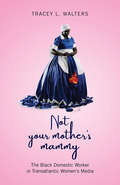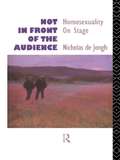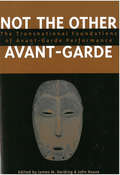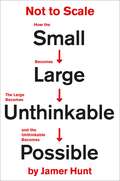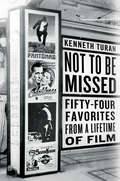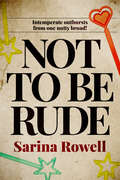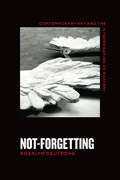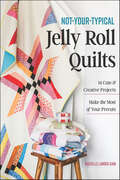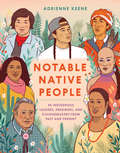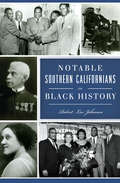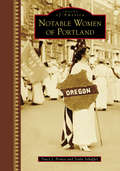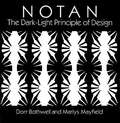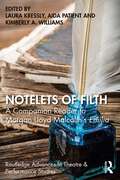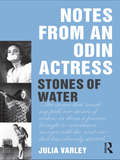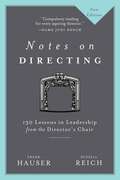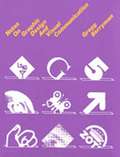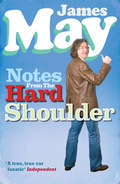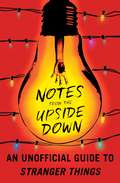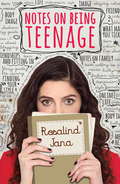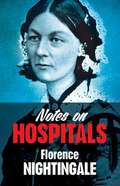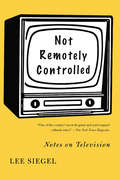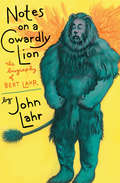- Table View
- List View
Not Your Mother's Mammy: The Black Domestic Worker in Transatlantic Women’s Media
by Tracey L WaltersNot Your Mother’s Mammy examines how black artists of the African diaspora, many of them former domestics, reconstruct the black female subjectivities of domestics in fiction, film, and visual and performance art. In doing so, they undermine one-dimensional images of black domestics as victims lacking voice and agency and prove domestic workers are more than the aprons they wear. An analysis of selected media by Alice Childress, Nandi Keyi, Victoria Brown, Kara Walker, Mikalene Thomas, Rene Cox, Lynn Nottage, and others provides examples of generations of domestics who challenged their performative roles of subservience by engaging in subversive actions contradicting the image of the deferential black maid. Through verbal confrontation, mobilization, passive resistance, and performance, black domestics find their voices, exercise their power, and maintain their dignity in the face of humiliation. Not Your Mother’s Mammy brings to life stories of domestics often neglected in academic studies, such as the complexity of interracial homoerotic relationships between workers and employers, or the mental health challenges of domestics that lead to depression and suicide. In line with international movements like #MeToo and #timesup, the women in these stories demand to be heard.
Not in Front of the Audience: Homosexuality On Stage
by Nicholas de JonghFirst published in 1992. Routledge is an imprint of Taylor & Francis, an informa company.
Not the Other Avant-Garde: The Transnational Foundations of Avant-Garde Performance
by John Rouse James Martin HardingAlmost without exception, studies of the avant-garde take for granted the premise that the influential experimental practices associated with the avant-garde began primarily as a European phenomenon that in turn spread around the world. These ten original essays, especially commissioned for Not the Other Avant-Garde, forge a radically new conception of the avant-garde by demonstrating the many ways in which the first- and second-wave avant-gardes were always already a transnational phenomenon, an amalgam of often contradictory performance traditions and practices developed in various cultural locations around the world, including Africa, the Middle East, Mexico, Argentina, India, and Japan. Essays from leading scholars and critics-including Marvin Carlson, Sudipto Chatterjee, John Conteh-Morgan, Peter Eckersall, Harry J. Elam Jr., Joachim Fiebach, David G. Goodman, Jean Graham-Jones, Hannah Higgins, and Adam Versényi-suggest collectively that the very concept of the avant-garde is possible only if conceptualized beyond the limitations of Eurocentric paradigms. Not the Other Avant-Garde is groundbreaking in both avant-garde studies and performance studies and will be a valuable contribution to the fields of theater studies, modernist studies, art history, literature, and music history.
Not to Scale: How the Small Becomes Large, the Large Becomes Unthinkable, and the Unthinkable Becomes Possible
by Jamer HuntFrom small decisions that paralyze us to big data that knows everything about us, Not to Scale is a thought-provoking guide to navigating the surprising complexities of a networked age when the things that are now shaping experience have no weight or size. The dictionary defines "scale" as a range of numbers, used as a system to measure or compare things. We use this concept in every aspect of our lives-it is essential to innovation, helps us weigh options, and shapes our understanding of the impact of our actions. In Not to Scale, Jamer Hunt investigates the complications of scale in the digital age, highlighting an interesting paradox: We now have a world of information at our fingertips, yet ironically the more informed we have become, the more overwhelmed we feel. The global effects of our daily choices (Paper or plastic? Own or lease? Shop local or buy online?) remain difficult for us to comprehend, and solutions to large-scale national and international issues feel inconceivable. Hunt explains how these challenges are intimately tied to a new logic of scale and provides readers with survival skills for the twenty-first century. By taking massive problems and shrinking them down to size, we can use scale to effect positive change and adapt to the modern era. Connecting our smallest decisions to the grand scheme of things, Not to Scale is a fascinating and empowering guide to comprehending and navigating the high stakes often obscured from our view.
Not to be Missed: Fifty-four Favorites from a Lifetime of Film
by Kenneth TuranAs a child in 1950s Brooklyn, Kenneth Turan often turned to television programs like "Million Dollar Movie" on WOR-TV. Featuring a much-loved theme song from Gone with the Wind, "Million Dollar Movie" would run one feature film twice a day, every day, all week. It was there that he developed a life-long love of the world of the movies.One of the most discerning critics writing today, Kenneth Turan offers insights that are sure to delight and inspire movie-lovers of all kinds in his latest book, Unforgettable. As sophisticated and illuminating as the films they discuss, Turan's sketches are a blend of cultural analysis, historical anecdote and sordid Hollywood controversy, astute critical appraisals, all suffused with his abiding love for the silver screen.Turan's favorite films range across all genres, low and high. From All About Eve to Seven Samurai to Spirited Away, these are now timeless films-classic and contemporary, familiar and obscure, with big budgets and small-each as interesting as the lives of the authors and actors that made the usually two-or-so-hour-long cinematic experience itself.Ernst Lubitsch loved to act out the scenes he was shooting in front of his cast. Laurence Olivier's torrid love affair with Vivien Leigh was the only reason he agreed to play the part of Mr. Darcy in Pride and Prejudice. John Boorman once said that "watching film is very like dreaming," and truly, the highly-stylized violence of Point Blank dares its audience to reconsider what they've seen on the screen.
Not to be Rude: Intemperate outbursts from one nutty broad!
by Sarina RowellNot to be Rude is a painfully assembled collection of writing by Sarina Rowell from cult humour websites The Scrivener's Fancy and Imagined Slights. Here, all in one place, for the first and last time, she goes into bat for the unfairly maligned - thirtysomething, Nicole Kidman, fashion models and being 'childless by choice'; and goes into bat against the unfairly non-maligned - tapas restaurants, second-hand booksellers, live performances and Audrey Hepburn. If you loved the BBC production of Pride and Prejudice with Colin Firth, you won't love Not to be Rude, and will, furthermore, be demonstrating your own terrible taste. 'Pretty damned funny.' -TONY MARTIN (the comedian, not the cyclist)
Not-Forgetting: Contemporary Art and the Interrogation of Mastery
by Rosalyn DeutscheExplores contemporary art that challenges deadly desires for mastery and dominion. Amid times of emboldened cruelty and perpetual war, Rosalyn Deutsche links contemporary art to three practices that counter the prevailing destructiveness: psychoanalytic feminism, radical democracy, and war resistance. Deutsche considers how art joins these radical practices to challenge desires for mastery and dominion, which are encapsulated in the Eurocentric conception of the human that goes under the name “Man” and is driven by deadly inclinations that Deutsche calls masculinist. The masculinist subject—as an individual or a group—universalizes itself, claims to speak on behalf of humanity, and meets differences with conquest. Analyzing artworks by Christopher D’Arcangelo, Robert Filliou, Hans Haacke, Mary Kelly, Silvia Kolbowski, Barbara Kruger, Louise Lawler, Martha Rosler, James Welling, and Krzysztof Wodiczko, Deutsche illuminates the diverse ways in which they expose, question, and trouble the visual fantasies that express masculinist desire. Undermining the mastering subject, these artworks invite viewers to question the positions they assume in relation to others. Together, the essays in Not-Forgetting, written between 1999 and 2020, argue that this art offers a unique contribution to building a less cruel and violent society.
Not-Forgetting: Contemporary Art and the Interrogation of Mastery
by Rosalyn DeutscheExplores contemporary art that challenges deadly desires for mastery and dominion. Amid times of emboldened cruelty and perpetual war, Rosalyn Deutsche links contemporary art to three practices that counter the prevailing destructiveness: psychoanalytic feminism, radical democracy, and war resistance. Deutsche considers how art joins these radical practices to challenge desires for mastery and dominion, which are encapsulated in the Eurocentric conception of the human that goes under the name “Man” and is driven by deadly inclinations that Deutsche calls masculinist. The masculinist subject—as an individual or a group—universalizes itself, claims to speak on behalf of humanity, and meets differences with conquest. Analyzing artworks by Christopher D’Arcangelo, Robert Filliou, Hans Haacke, Mary Kelly, Silvia Kolbowski, Barbara Kruger, Louise Lawler, Martha Rosler, James Welling, and Krzysztof Wodiczko, Deutsche illuminates the diverse ways in which they expose, question, and trouble the visual fantasies that express masculinist desire. Undermining the mastering subject, these artworks invite viewers to question the positions they assume in relation to others. Together, the essays in Not-Forgetting, written between 1999 and 2020, argue that this art offers a unique contribution to building a less cruel and violent society.
Not-Forgetting: Contemporary Art and the Interrogation of Mastery
by Rosalyn DeutscheExplores contemporary art that challenges deadly desires for mastery and dominion. Amid times of emboldened cruelty and perpetual war, Rosalyn Deutsche links contemporary art to three practices that counter the prevailing destructiveness: psychoanalytic feminism, radical democracy, and war resistance. Deutsche considers how art joins these radical practices to challenge desires for mastery and dominion, which are encapsulated in the Eurocentric conception of the human that goes under the name “Man” and is driven by deadly inclinations that Deutsche calls masculinist. The masculinist subject—as an individual or a group—universalizes itself, claims to speak on behalf of humanity, and meets differences with conquest. Analyzing artworks by Christopher D’Arcangelo, Robert Filliou, Hans Haacke, Mary Kelly, Silvia Kolbowski, Barbara Kruger, Louise Lawler, Martha Rosler, James Welling, and Krzysztof Wodiczko, Deutsche illuminates the diverse ways in which they expose, question, and trouble the visual fantasies that express masculinist desire. Undermining the mastering subject, these artworks invite viewers to question the positions they assume in relation to others. Together, the essays in Not-Forgetting, written between 1999 and 2020, argue that this art offers a unique contribution to building a less cruel and violent society.
Not-Your-Typical Jelly Roll Quilts
by Michelle Lander CainTransform Jelly Rolls into stunning quilted creations! Can you believe these stunning quilts are made with Jelly Rolls? Absolutely! These innovative patterns demonstrate that the versatile 2½” precut strips are capable of far more than you ever imagined! Discover how Jelly Rolls provide a diverse sampling of fabric without overwhelming your stash or budget. Explore dynamic projects that use a variety of shapes like squares, long rectangles, half-rectangle triangles, half-hexagons, and more! Featuring novelty blocks like rainbows, whales, and cats, the projects range from charming wallhangings to impressive queen-size quilts. Move beyond the “quick to sew” concept and elevate your Jelly Roll quilts! Create 14 projects ranging from wallhangings to bed-size quilts with ideas for using up Jelly Roll scraps Bust your precut stash with a versatile array of Jelly Roll designs that go beyond the expected Explore a spectrum of quilt patterns, from playful and childlike to charming and modern
Notable Native People: 50 Indigenous Leaders, Dreamers, and Changemakers from Past and Present
by Adrienne KeeneAn accessible and educational illustrated book profiling 50 notable American Indian, Alaska Native, and Native Hawaiian people, from NBA star Kyrie Irving of the Standing Rock Lakota to Wilma Mankiller, the first female principal chief of the Cherokee NationCelebrate the lives, stories, and contributions of Indigenous artists, activists, scientists, athletes, and other changemakers in this beautifully illustrated collection. From luminaries of the past, like nineteenth-century sculptor Edmonia Lewis—the first Black and Native American female artist to achieve international fame—to contemporary figures like linguist jessie little doe baird, who revived the Wampanoag language, Notable Native People highlights the vital impact Indigenous dreamers and leaders have made on the world. This powerful and informative collection also offers accessible primers on important Indigenous issues, from the legacy of colonialism and cultural appropriation to food sovereignty, land and water rights, and more. An indispensable read for people of all backgrounds seeking to learn about Native American heritage, histories, and cultures, Notable Native People will educate and inspire readers of all ages.
Notable Southern Californians in Black History (American Heritage)
by Robert Lee JohnsonThe contribution of Black men and women throughout the history of California is often overlooked because it doesn’t easily fit into the established narrative. In Los Angeles, over half of the original settlers were of African descent. These settlers left New Spain for the northern frontier to escape the oppression of the Spanish caste system, just as the racially oppressive Jim Crow laws propelled a similar migration from the American South 150 years later. Pioneers and politicians, as well as entrepreneurs and educators, left an indelible mark on the region’s history. Robert Lee Johnson offers the story of a few of the notable Black men and women who came to Southern California seeking opportunity and a better life for their families.
Notable Women of Portland
by Tracy J. Prince Zadie J. SchafferThe story of Portland, Oregon, like much of history, has usually been told with a focus on male leaders. This book offers a reframing of Portland’s history. Many women made their mark and radically changed the Oregon frontier, including Native Americans Polly Johnson and Josette Nouette; pioneers Minerva Carter and Charlotte Terwilliger; doctors Marie Equi, Mary Priscilla Avery Sawtelle, and Bethina Owens-Adair; artists Eliza Barchus and Lily E. White; suffragists Abigail Scott Duniway, Hattie Redmond, and Eva Emery Dye; lawyer Mary Gysin Leonard; Air Force pilot Hazel Ying Lee; politicians Barbara Roberts and Margaret Carter; and authors Frances Fuller Victor, Beverly Cleary, Beatrice Morrow Cannady, Ursula Le Guin, and Jean Auel. These women, along with groups of women such as “Wendy the Welders,” made Portland what it is today.
Notan: The Dark-Light Principle of Design (Dover Art Instruction)
by Dorr Bothwell Marlys MayfieldAs a guiding principle of Eastern art and design, Notan (a Japanese word meaning dark-light) focuses on the interaction between positive and negative space, a relationship embodied in the ancient symbolism of the Yang and the Yin. In composition, it recognizes the separate but equally important identity of both a shape and its background.Since their introduction in the West, the intriguing exercises associated with Notan have produced striking results in every branch of Western art and design. This book, by two American artists and teachers who made an intensive study of Notan, was the first basic book on the subject in the West, and it remains one of the definitive texts. Through a series of simple exercises, it places the extraordinary creative resources of Notan easily within the grasp of Western artists and designers.Clearly and concisely, the authors demonstrate Notan's practical applications in six problems of progressive difficulty -- creative exercises that will fascinate artists and designers of every calling and level of expertise. Along with these exercises, the book includes many illustrations of the principle of Notan, among them images as diverse as a sculpture by David Smith, a Samoan tapa cloth, a Museum of Modern Art shopping bag, New England gravestone rubbings, Japanese wrapping paper, a painting by Robert Motherwell, a psychedelic poster, and a carved and dyed Nigerian calabash. Painters, sculptors, potters, jewelry, and textile designers, architects, and interior designers all will discover -- or rediscover -- in these pages an ancient principle of composition that can help them meet creative challenges with fresh new perspective.
Notelets of Filth: A Companion Reader to Morgan Lloyd Malcolm's Emilia (Routledge Advances in Theatre & Performance Studies)
by Morgan Lloyd Malcolm Aida Patient Kimberly A. Williams Laura KresslyThis collection of short, accessible essays serves as a supplementary text to Morgan Lloyd Malcolm’s play, Emilia. Critically acclaimed and beloved by audiences, this innovative and ground-breaking show is a speculative history, an imaginative (re)telling of the life of English Renaissance poet Aemilia Bassano Lanyer. This book features essays by theatre practitioners, activists, and scholars and informed by intersectional feminist, critical race, queer, and postcolonial analyses will enable students and their teachers across secondary school and higher education to consider the play’s major themes from a wide variety of theoretical and interdisciplinary perspectives. This volume explores the current events and cultural contexts that informed the writing and performing of Emilia between 2017 and 2019, various aspects of the professional London productions, critical and audience responses, and best practices for teaching the play to university and secondary school students. It includes a foreword by Emilia playwright Morgan Lloyd Malcolm This book will be of great interest to students and scholars of theatre, arts activism, feminist literature, and theory.
Notes From An Odin Actress: Stones of Water
by Julia Varley‘As an actress I sit, speak, run, sweat and, simultaneously, I represent someone who sits, speaks, runs and sweats. As an actress, I am both myself and the character I am playing. I exist in the concreteness of the performance and, at the same time, I need to be alive in the minds and senses of the spectators. How can I speak of this double reality?’ – Julia Varley This is a book about the experience of being an actress from a professional and female perspective. Julia Varley has been a member of Odin Teatret for over thirty years, and Notes from an Odin Actress is a personal account of her work with Eugenio Barba and this world-renowned theatre company. This is a unique window onto the in-depth exercises and day-to-day processes of an Odin member. It is a journal to enlighten anyone interested in the performances, the discoveries and the hard physical work that accompany a life in theatre.
Notes On Directing: 130 Lessons In Leadership From The Director's Chair
by Frank Hauser Russell ReichSome years ago, Frank Hauser, then a retired freelance director, and writer Russell Reich, his former student, self-published Notes on Directing in hardcover. It was immediately acclaimed as “a gem-witty and full of insight;” “so sensible, so complete, and so right;” and “amazingly illuminating” by the likes of Judi Dench, Edward Albee, and Terry Teachout. Gathered over Frank Hauser's long career, and polished to a sharp edge by Russell Reich, the 130 "Notes" address a wide range of topics, from understanding the script and defining the director's role, to casting, how to handle a first read-through of a script, rules for rehearsal, how to talk to actors, how to get a laugh, and the key elements of staging. Filled with enduring good advice expressed in assertive, no-nonsense language, and supported with explanatory commentary, insightful quotes and examples, and six valuable appendices, this deceptively slim book has the impact of a privileged apprenticeship, providing deep insight into the hidden process of creating a live, shared experience. For the student or professional engaged in a directing or acting career, the executive or manager looking for inspiring new ideas on leadership, or the arts lover wanting insight into the creative process, this book will be an invaluable experience. This new edition includes an interview with the co-author.
Notes On Graphic Design And Visual Communications
by Gregg BerrymanEssential design information that provides a visual vocabulary and an introduction to concepts of design based on the work of well-known designers.
Notes from the Hard Shoulder
by James MayTop Gear presenter and columnist for the Daily Telegraph James May brings together another brilliant collection of his most controversial and humorous writing. From tales of motoring adventures through India, Russia and Iceland, to classic articles on essential subjects such as driving songs and haunted car parks, these gems from the number one car connoisseur will take readers on a motoring journey that will amuse and entertain in equal measure.
Notes from the Upside Down: An Unofficial Guide to Stranger Things
by Guy AdamsJump inside the world of Stranger Things and discover everything you need to know about the hit TV show.Grab your Eggo waffles and get ready for a visit to Hawkins, Indiana—just don’t forget the fairy lights! If you devoured Stranger Things on Netflix and you’re looking to fill the demogorgon-sized hole in your life, then look no further than Notes from the Upside Down. This fan-tastic guide has every fact you could ever wish for—from insights into the origins of the show, including the mysterious Montauk Project conspiracy theory; a useful eighties playlist (because, of course); and much more. If you’ve ever wondered why Spielberg is such a huge influence, which Stephen King books you need to read (hint: pretty much all of them), or how State Trooper David O’Bannon earned his name, then this book is for you. Entertaining, informative, and perfect for fans of eighties pop culture, Notes from the Upside Down is the Big Mac of unofficial guides to Stranger Things—super-sized and special sauce included.
Notes on Being Teenage
by Rosalind JanaHow would you describe yourself? Do you like to stand out, or fit in? Are you an Instagram junkie, or is Snapchat more your thing? Are you watching Zoella on YouTube, or reading Rookie on your phone? We're all different, and no-one's teenage years are the same. But we do all have one thing in common - being a teenager is about discovering who we are, and who we want to be. It can be tricky, building and forming your own identity and sense of self, and sometimes, advice from someone who has been there and done it in the not-too-distant past can come in useful. Enter Rosalind Jana, who's crammed more into her 20-odd years than most (including winning the Vogue Talent Contest for Young Writers AND 'Well Dressed' at the Observer Ethical Awards, but don't tell her we told you that...). Notes on Being Teenage covers all aspects of teenhood, from the serious (mental health issues, bullying, staying safe online), to the slightly-less-so (dating, style, fashion, starting a blog) and everything in between. Rooted in her own experiences as a blogger, part-time model and eco-fashion-expert, but also as a teen who struggled with scoliosis, bullying and her dad's depression, Rosalind is well-placed to offer advice and guidance to anyone navigating their teenage years. She's also spoken to loads of teens about their experiences, too, and their stories, problems, advice and wisdom are gathered here as well, along with interviews with inspirational and interesting people like Louise O'Neill, Juno Dawson and Rosianne Halse-Rojas. All this combines to form a warm, witty, wise book not just on how to survive but how to thrive as a teen. Essential reading for smart girls of any age.
Notes on Being Teenage
by Rosalind JanaHow would you describe yourself? Do you like to stand out, or fit in? Are you an Instagram junkie, or is Snapchat more your thing? Are you watching Zoella on YouTube, or reading Rookie on your phone? We're all different, and no-one's teenage years are the same. But we do all have one thing in common - being a teenager is about discovering who we are, and who we want to be. It can be tricky, building and forming your own identity and sense of self, and sometimes, advice from someone who has been there and done it in the not-too-distant past can come in useful. Enter Rosalind Jana, who's crammed more into her 20-odd years than most (including winning the Vogue Talent Contest for Young Writers AND 'Well Dressed' at the Observer Ethical Awards, but don't tell her we told you that...). Notes on Being Teenage covers all aspects of teenhood, from the serious (mental health issues, bullying, staying safe online), to the slightly-less-so (dating, style, fashion, starting a blog) and everything in between. Rooted in her own experiences as a blogger, part-time model and eco-fashion-expert, but also as a teen who struggled with scoliosis, bullying and her dad's depression, Rosalind is well-placed to offer advice and guidance to anyone navigating their teenage years. She's also spoken to loads of teens about their experiences, too, and their stories, problems, advice and wisdom are gathered here as well, along with interviews with inspirational and interesting people like Louise O'Neill, Juno Dawson and Rosianne Halse-Rojas. All this combines to form a warm, witty, wise book not just on how to survive but how to thrive as a teen. Essential reading for smart girls of any age.
Notes on Hospitals: Being Two Papers Read Before The National Association For The Promotion Of Social Science, At Liverpool, In October 1858
by Florence NightingaleThe founder of modern nursing expressed her revolutionary ideas of hospital reform in these two essays, published in 1859 and presented the previous year at the Social Science Congress. During the Crimean War, Florence Nightingale achieved renown as The Lady with the Lamp, the tireless caretaker of wounded soldiers. Afterward, Nightingale searched Europe for innovations to help the army improve its hospital care. This report of her findings and suggestions had a profound effect on the medical community and reestablished the author as an international healthcare authority.Despite the advances in medical knowledge since Nightingale's era, her common-sense approach continues to form a solid foundation for nursing. In these essays she voices the importance of hygiene―fresh air and water, cleanliness, proper drainage, and ample light―as well as ongoing consideration for patients' feelings. Nightingale's ability to effectively articulate her ideas impressed her contemporaries and continues to influence modern readers. This volume serves as a companion to Nightingale's classic of nursing literature, Notes on Nursing: What It Is, and What It Is Not.
Notes on Television: Notes on Television
by Lee SiegelTelevision has taken firm hold of American life ever since the first flickering images replaced the disembodied voices innocently crackling from the radio. Ever present and evolving, television thrives at the crossroads of commerce, art, and entertainment. In Not Remotely Controlled cultural critic Lee Siegel collects his reportage and musings on this most hybrid medium. Whether chronicling the history of the "cop” drama, revealing the inherent irony in Donald Trump’s character on "The Apprentice,” or shedding light on those unheralded gems that Neilsen ratings swept away prematurely, Siegel gives each episode, series, or documentary the attention and respect usually reserved for high-art and dusty literature. Going far beyond mere pans and praise, Siegel has given long-overdue attention to America’s most pervasive art form: television.
Notes on a Cowardly Lion: The Biography of Bert Lahr
by John LahrJohn Lahr&’s stunning and complex biography of his father, the legendary actor and comedian Bert Lahr Notes on a Cowardly Lion is John Lahr&’s masterwork: an all-encompassing biography of his father, the comedian and performer Bert Lahr. Best known as the Cowardly Lion in MGM&’s classic The Wizard of Oz, Lahr was a consummate artist whose career spanned burlesque, vaudeville, Broadway, and Hollywood. While he could be equally raucous and polished in public, Lahr was painfully insecure and self-absorbed in private, keeping his family at arm&’s length as he quietly battled his inner demons. Told with an impressive objectivity and keen understanding of the construction—and destruction—of the performer, Notes on a Cowardly Lion is more than one man&’s quest to understand his father; it is an extraordinary examination of a life in American show business.
